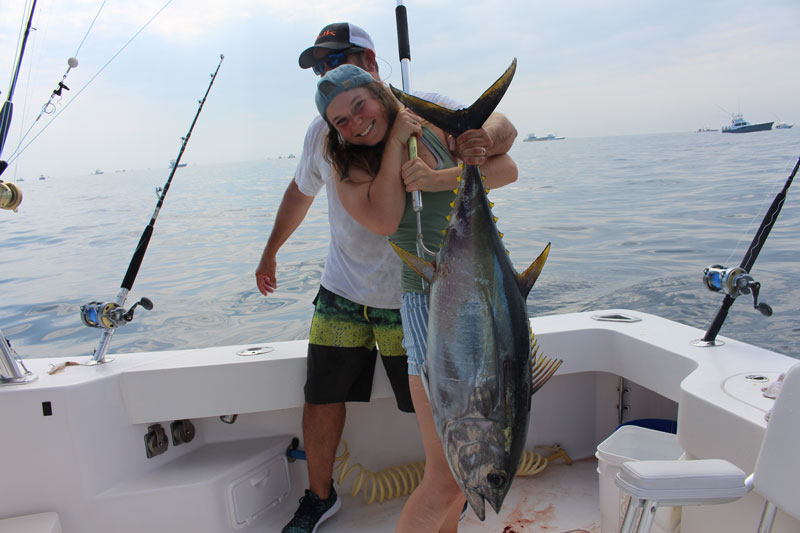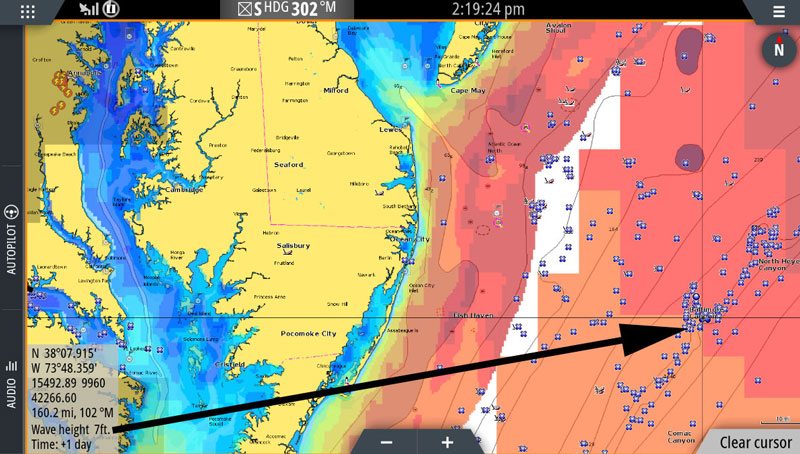Maybe you got a taste of tuna trolling on a charter boat trip, a buddy turned you on to the thrill of watching a marlin attacking a bait, or you got a bit adventurous and ran your own boat through the inlet last summer. Whatever the case may be, the offshore fishing bug has bit — and it bit hard. Now, you say you want to get serious about taking your fishing adventures to the next level.

Gearing Up for Offshore Fishing
If you want to score offshore on a regular basis, those old Senators and your 1990s vintage electronics will no longer prove sufficient. Big pelagic beasts will make a mockery of your efforts if you try to “just get by” with sub-par gear. Yes, we know it’s a significant expense to arm yourself, but if someone told you offshore fishing could be done on the cheap we’re guessing their experience is limited to fishing for carp in Pennsyltucky.
Offshore Rods and Reels
Consider 30-pound-class light gear, 50 middle of the road, and 80 heavy. If you plan to bailing for mahi you’ll want 20- to 30-pound spinning gear and if deep dropping is in the cards you need high-speed reels or electrics spooled with 50-pound or heavier braid.
Offshore Fishing Lures and Rigs
If you plan to troll for tunas, spreader bars or side-trackers and skirted ballyhoo rigs are must-haves. Many seasoned offshore anglers would add Green Machines and/or Tuna Clones, bird rigs, and blue/white Ilanders to this list. For those targeting whites naked ‘hoo rigs are also a must. And if wahoo are a prime target be sure to have some purple/black skirted baits with a wire trace.
Electronics
Your main concern when it comes to electronics should be getting to where you’re going and back home again safely. You’ll want a reliable modern chartplotter with satellite weather service, and as you’ve probably already heard us shouting from the mountaintop, that means getting SiriusXM. Along with the safety margin of having satellite weather service including thunderstorm tracking and lightning strike indication displayed on your MFD, you can also sign on for Fish Mapping and gain an edge over the other anglers out there with up-to-date SST temperature break charting, chlorophyll charts, and more. Added bonus: SiriusXM is a FishTalk supporter, so they’re helping us bring you angling intel including this very article. We love ‘em for it and you should, too!

On top of your primary system you should also have some form of backup navigation. Electronic gremlins can and will appear, and when they do, you’ll be glad you have that handheld GPS (and fresh spare batteries). And of course, no boat should leave the inlet without a compass aboard.
As for fishfinders, “scanners” and their shorter ranges are less helpful than traditional sounders when you’re out in the deep. Being able to read bait in the top 100 to 200 feet of the water column and being able to touch bottom in 1000-plus feet of water are both things you’ll want to be able to do. Just as important for trolling up pelagics is making sure you have a good temp gauge including a historic graph presentation to read the breaks.
Additional Gear for Offshore
You need at least two gaffs because sooner or later, a hot fish WILL rip one out of your hands. It’s nice to have one with a small gap for fish with slim bodies like mahi and wahoo. It’s also good to have a bat for subduing big fish that come in hot. Nets are useless on most pelagics — they’ll swim right through the mesh — but if you’re going to target tilefish or black sea bass they’re handy. And tying knots in anything over 60 pound-test is folly, so you also need to carry a pair of crimpers and a set of crimps. All the other usual stuff like pliers, cutters, a knife, cutting board, five-gallon bucket, etc. should be onboard as well.
When to Head Offshore
Judgement Call
The biggest factor when it comes to captaining a boat offshore is your own personal experience level and judgement. In many cases you’ll have better luck and a higher level of safety aboard a 26-footer with a seasoned captain than you would on a 50-footer run by a noob.
There’s no substitute for time on the water, so how can you go from fresh meat to sharpie overnight? You can’t. You should gain some basic skills by doing more of those trips with friends and charters, and expect that the first couple of seasons you run your own boat offshore your level of success may not be off the charts. But don’t worry — learning is all part of the game. And with a few years of offshore angling under your belt, you’ll soon be biting that fishing bug right back.
The Go/No-Go Call
One of the most critical parts of captaining a boat is knowing when to say no. Truth be told, this article was originally supposed to be based on a trip offshore with a SiriusXM pro, Captain Andrew Snell of Good Company Fishing, in Ocean City, MD. But when he looked at the MFD displaying seas of seven feet out of the northeast in our target zone for the next day, he made the call to cancel the trip. Wisely — seven footers in a 34-foot CC make for a miserable day. Here’s what Captain Snell has to say about having near real-time weather at the helm, and how it helps him make smart calls.
Q: How helpful is it to have SiriusXM on the boat when it’s decision-time?
A: Incredibly. I can pull it up and see thunderstorms and the direction they’re heading, which can dictate which way we head in the morning. Out on the water I know whether to head in or push out farther to avoid getting caught in anything nasty. And when we plan to stay out overnight it’s great to be able to get an updated forecast hours after we’ve left the dock.
Q: Has having weather aboard ever saved the day?
A: (Laughs), It’s saved us a bunch of times. One year during the White Marlin Open we really needed to get out but there was a line of bad thunderstorms five miles off the beach. We ran up the beach, then turned east in just the right spot to avoid getting hit.
Q: What’s your favorite feature of having SiriusXM?
A: We use the Fish Mapping to help decide where to go for sure, but since I’m in a center console and don’t have the comfort level of some of the big sportfishers in storms, the weather service is definitely my favorite.
For more on offshore fishing, see Coastal Correspondant John Unkart's article, What it Takes to be Successful Offshore.